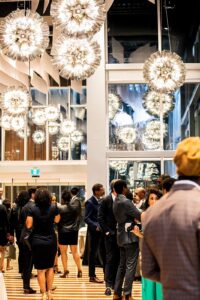Most companies measure their event success by attendance.
But if you’re only counting heads, you’re missing the point… and the opportunity.
A well-designed corporate event isn’t just a celebration or networking opportunity. It’s a strategic tool that drives measurable outcomes: stronger relationships, improved brand perception, deeper engagement, and tangible business growth. At Debonair Corporate Events, we call that designing for ROI: Return on Investment, Return on Objectives, and Return on Experience.
The Real Meaning of ROI in Events
Traditionally, ROI is seen as a financial formula:
(Revenue Generated – Event Cost) ÷ Event Cost × 100.
That’s useful when you’re calculating direct sales from trade shows or sponsorship returns, but it’s incomplete for most corporate events. In fact, 83% of marketing leaders say proving ROI, especially for events, remains one of their biggest challenges (Amra and Elma, 2024 Event Marketing Statistics Report).
The reason? Events create impact that isn’t always captured by spreadsheets: impact on brand loyalty, culture, retention, and perception.
That’s where ROO (Return on Objectives) and ROE (Return on Experience) come in.
They measure whether your event achieved its strategic goals and how it made people feel in the process.
An event designed around ROO and ROE doesn’t just meet KPIs. It builds momentum long after the lights dim.
Why Measuring Matters More Than Ever
In 2025, event budgets are tightening while expectations continue to rise. Cost control is a major concern for 75% of planners, and 60% say demonstrating event ROI is now a key priority (Cvent, Event Statistics Report 2024).
At the same time, 84% of marketers say events help their company stand out from the competition, and 83% say events are critical to driving business growth (Cvent, Event Statistics Report 2024).
That combination of higher accountability and greater opportunity means event strategy has to evolve. Companies that measure ROI effectively allocate budgets more strategically, design experiences that convert, and strengthen long-term relationships. Those that don’t risk treating events as cost centres instead of growth drivers.
Designing Events for Measurable Results
Every high-performing event starts with one question:
“What do we want people to think, feel, and do when they leave?”
That answer becomes the foundation for design, engagement, and data collection. Here’s how leading organizations and our clients use that approach to drive outcomes:
1. Define clear objectives
Before booking the venue or designing the stage, define the “why.”
Are you trying to build brand awareness, strengthen internal culture, attract clients, or celebrate milestones? Clarity here determines what metrics you’ll track later, from lead quality to employee sentiment.
2. Align experience with outcomes
The environment, programming, and flow of an event should all support the objectives. At Debonair, we build design frameworks that align with our clients’ business goals.
For example, when we produced the Building Diversity Awards, the strategy wasn’t just to host a gala. It was to drive awareness and investment in inclusion initiatives.
The result? A 40% increase in sponsorship engagement year over year, plus expanded media coverage across multiple regions.

3. Collect both data and emotion
Metrics tell one part of the story, but emotion drives decisions.
Post-event surveys, engagement analytics, and sentiment tracking tools measure how attendees felt about the experience. Studies show that 91% of attendees say a
well-produced event positively changes their perception of a brand (Performit Live, 2024).
That’s measurable ROI. It influences purchasing, advocacy, and retention
4. Analyze and optimize
What worked? What didn’t?
Events should be treated like campaigns that are reviewed, refined, and optimized. We apply a post-event debrief that evaluates ROI through multiple lenses: attendance vs. target, engagement rates, cost-per-touchpoint, and long-term brand lift.
ROI in Action: The Ripple Effect
One of the most overlooked aspects of event ROI is its ripple effect. 
When a corporate gala or conference is strategically executed, the benefits extend far beyond the event day:
• Employee Engagement: Companies with strong event cultures see a 31% increase in employee productivity (Gallup, State of the Global Workplace 2024).
• Brand Trust: In-person experiences shape how people feel about the brands behind them. 77% of attendees say their trust in an organization increases after experiencing it in person, and most retain that positive impression for weeks afterward (Freeman, 2024).
• Retention and Loyalty: Employees who build strong social connections at work are up to 50% more likely to stay with their organization. In-person events play a key role in creating space for those relationships to form and deepen (HR Exchange Network, 2024).
These aren’t abstract numbers. They represent stronger teams, more loyal clients, and measurable growth.
The Future of ROI: Human + Data
The future of corporate events will merge emotional design with data intelligence.
AI tools now make it possible to measure engagement in real time, track sentiment through surveys or social activity, and visualize ROI dashboards immediately after the event.
But technology only enhances what great strategy already delivers: connection, belonging, and purpose.
At Debonair Corporate Events, we believe ROI isn’t just about numbers. It’s about meaning. When an event inspires people to act, engage, or believe differently, that is a return worth measuring.
Final Takeaway
If your next event is simply about gathering people, you’ll get attendance. If it’s about aligning strategy, experience, and outcomes, you’ll get impact.
Let’s make your next event perform as well as it inspires.
Book a Vision Call to learn how we design events that deliver measurable results.


